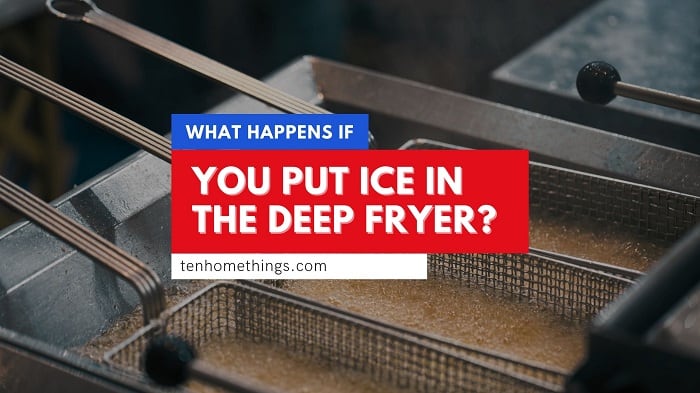Have you ever had a nagging intrusive thought that said, “What will happen if I put ice in the deep fryer?”
Many people have, and some have even chosen to try it for themselves.
Putting ice in a deep fryer is a terrible idea, with no tangible benefits and a slew of potential outcomes, most of which are intensely dangerous and unfortunate. Don’t try this yourself! Instead, watch videos on the internet of people who already did it and learn from their mistakes!
Table Of Contents:
What Happens If You Put Ice in the Deep Fryer?
A few things can happen if you put ice in a hot deep fryer. First, regardless of how much oil and ice you use, the ice will melt and boil very quickly. This violent reaction can expel hot liquid and vapor in all directions, leading to other problems. For instance, if an open flame is nearby, the hot oil in the steam can ignite.

This can be seen in a YouTube video by Marshal Ramer titled: “This Is Why You Should NEVER Throw Icecubes Into a Deep Fat Fryer!!” In this video, a guy uses a makeshift deep fryer with a propane burner and a bucket. Due to the open flame below the bucket, the moment hot oil and steam mixture flies out of the bucket, it’s ignited. Massive flames erupted from the bucket, so much so, his cameras weren’t close enough to see the full flame at once. This may be a worst-case scenario, but one to be weary of nonetheless.
If only a small amount of ice is used and there is plenty of space in the oil vat to hold the foamy steam bubbles, you’ll likely get a result more like this classic video from 2009 titled “Ice in the Frialator.” In this video, you can see the oil bubbling up enough to fill up the fryer for a few seconds, and then the reaction dies down without causing much of a mess or danger. This is the absolute best-case scenario; even if doing this can cause a minor effect, you should not repeat it.
back to menu ↑
Can You Deep Fry Ice?
As it appears, the concept of deep-frying ice is worthless. You can put ice in a hot deep fryer, but there’s not a good chance you’ll end up with anything you can eat, and you’ll most likely create a massive mess and a dangerous situation for everyone around you. Do not deep fry ice.
back to menu ↑
Why Ice Reacts With Hot Oil
There’s no secret chemical reaction between ice and hot oil, but there is some science behind it. The temperature difference between the ice and the oil is so significant that the ice instantly goes from frozen to liquid, then liquid to gas, increasing its volume by over a thousand times. This means there’s a lot of steam in a small space where the ice and liquid water once were, meaning the pressure is very high.
This extremely high pressure rapidly expels oil from the fryer, which is hot enough to burn somebody and easily ignite. This is why it’s so dangerous to pour water on a grease fire; the same expansion occurs, sending oil flying everywhere. Also, water doesn’t mix with oil, so it does very little to quench the flames and spreads the hot oil across a surface more quickly.
back to menu ↑
Is There Any Way to Fry Ice?
Many people have tried to fry ice, but by far, the most interesting thing that happens is the dangerous reaction, and they never seem to be left with something edible. However, there is such a thing as deep-fried water, although it’s not simply water that you stick in the hot oil. You must make the water into a sort of gelatin before it can be battered and fried.
back to menu ↑
Deep Fryer Safety Guidelines
Read your fryer’s manual to familiarize yourself with how it works.
To make sure you’re properly using your deep fryer, the best thing you can do is read the manual. It will give you details that will help ensure you’re putting the right amount of food in at one time, using the right kinds of oil, and taking care of your fryer.
Dry off wet foods and remove ice chunks from frozen foods before putting them in hot oil.
We already know what can happen when you put water or ice into your deep fryer. Don’t do it!
Never fill oil above the MAX FILL mark.
In case a bit of moisture or frost gets into the oil, you want it to have plenty of room to bubble up. If the oil level is too high, it’ll overflow easily, causing more damage and danger than necessary.
Choose an oil with a higher smoke point than your cooking temperature.
Smoke points are the temperature levels at which a particular oil will break down and emit smoke. Olive Oil, Peanut Oil, Sesame Seed Oil, and Vegetable Oil have smoke points above 400 degrees Fahrenheit. Use something with a high smoke point, never exceed that temperature, and filter your oil regularly. For example, this recipe for San Tung Chicken Wings calls for vegetable oil at 375 degrees!
Always measure the internal temperature of meats like fish and poultry.
Foods like fish and chicken need to be brought up to a specific temperature before they are considered safe to consume. Chicken needs to reach 165 Fahrenheit, while beef, pork, fish, and seafood need to be at least 145 degrees Fahrenheit. It’s always recommended to cook ground meats to at least 160 degrees to be safe. It also helps to make sure you’re using small enough pieces to cook the center quickly.
If you’re looking for some budget knives to cut up your meat, AmazonBasics knife sets are some of the cheapest sets of high-quality cutlery.
back to menu ↑
Conclusion
While deep frying can be a safe and effective way to cook some of your favorite foods, there are dangers involved when it’s done improperly. Food can be undercooked, leading to foodborne illnesses. You could inhale fumes from the oil getting hotter than its smoke point. As we’ve seen today, ice or water can cause massive overflows and spew clouds of hot oil droplets. It’s essential when using a deep fryer, or when cooking in general, to take steps to ensure it’s done as safely as possible.
back to menu ↑
Frequently Asked Questions
Why does ice make deep fryers overflow?
The rapidly evaporating and expanding water takes oil with it, which creates bubbles and splashes of oil. If enough of these tiny water droplets become steam, the oil will foam up and fill a lot more space. This can cause the oil to overflow and pour onto the ground, where it can burn your feet, your pets, or anything else on the floor.
back to menu ↑
Can frying ice create an explosion?
As showcased in Marshal Ramer’s video, the powerful reaction caused when the water molecules evaporate shoots the oil and steam mixture in all directions. When there’s enough ice in the hot oil, a violent expansion results. If this hot, volatile cloud comes in contact with any open flames or sparks, it could ignite, and the fiery explosion could be hazardous and hard to control.
back to menu ↑
Is it safe to put ice in an oven?
It is generally safe to put ice in the oven, and it’s actually recommended when baking bread in a residential oven. This is because the steam produced by the ice keeps the temperature a bit lower and more stable and keeps the bread from absorbing too much heat and moisture. It actually helps to create a crust on the bread and will cook it more quickly and rise more evenly.
back to menu ↑
What happens if you put ice on a grill?
If you put a piece of ice on a hot grill, it might skate around and make funny noises. Some people use lemon juice with ice cubes to clean their flattop grills. However, many experts will recommend avoiding putting ice on your grills or griddles because the temperature difference between the hot grill and the ice can shock the surface and cause warps or cracks. Lemon juice, however, is widely used to clean grills as the acid in it breaks down oil easily.
back to menu ↑
What happened in the deep frying ice meme video?
A trending TikTok video last year showed a fast food restaurant employee dipping a basket of ice into a deep fryer. The basket was nearly full of ice cubes, and they left it in the fryer. Next, brown bubbles filled the entire basin and began overflowing rapidly. The video cuts to a scene with murky brown oil covering the ground, a waterfall of oil pouring over the counter, and fire alarms blaring.
This is an excellent example of what can happen if you put a lot of ice into a deep fryer, but it’s not the worst thing that can happen. These people were lucky that the foamy oil that bubbled up to the top of the fryer had no ignition source nearby. If it had, there may have been a fiery explosion that could seriously injure somebody or even cause death.
back to menu ↑
Can water be deep-fried?
There has been another TikTok trend involving deep-fried water. However, making such a thing is not as simple as coating water in flour, eggs, and breadcrumbs and throwing it into a deep fryer. You must first use chemicals like calcium chloride and sodium alginate to give the water into a gelatinous membrane. Once you’ve done this, you can coat and fry it like anything else.
It will be very bland and lack nutritional content, but it might be a funny thing to feed to a guest for a laugh. A video from 2016 titled ‘deep fried water’ shows a guy doing this very thing with calcium alginate.
back to menu ↑
Why can you deep fry ice cream?
You would think that if you can’t deep fry ice, you probably also can’t deep fry ice cream. However, you can! Deep-fried ice cream is a delicacy created by frying ice cream in a deep fryer, usually in the form of balls. Each ice cream ball is wrapped in something insulative like pound cake and stuck back into the freezer.
When they’re hardened, they can be dipped in a breading mixture of egg and flour and then deep-fried. The result is delectable breaded ice cream balls to which you can add your favorite fruits or toppings.
Shanny
Shanny not only has an exceptional understanding of the foodie mindset and how nutrition works, she has also achieved her Master’s Degree in Education. Outside of her academic achievements, she loves writing food blogs. It's so much more than a list of meals though! Shanny creates helpful cookware guides and delicious recipes that are easy to follow. She does all of this as a food blog writer because she loves it. That's why she spends lots of time testing out different recipes in her own home. She truly is a one-of-a-kind foodie, from her home to yours - with a story to tell, new recipes to indulge in and new tips to tantalize those tastebuds.












